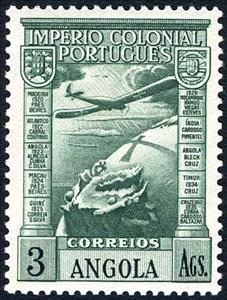Stamp: Airplane over globe (Angola 1938)
Airplane over globe (Angola 1938)
01 August (Angola ) within release Portuguese Empire goes into circulation Stamp Airplane over globe face value 3 Angolan angolar
| Stamp Airplane over globe in catalogues | |
|---|---|
| Michel: | Mi:AO 289 |
Stamp is vertical format.
Also in the issue Portuguese Empire:
- Stamp - Vasco da Gama (1469-1524) face value 1;
- Stamp - Vasco da Gama (1469-1524) face value 5;
- Stamp - Vasco da Gama (1469-1524) face value 10;
- Stamp - Vasco da Gama (1469-1524) face value 15;
- Stamp - Vasco da Gama (1469-1524) face value 20;
- Stamp - Mousinho de Albuquerque face value 30;
- Stamp - Mousinho de Albuquerque face value 35;
- Stamp - Mousinho de Albuquerque face value 40;
- Stamp - Mousinho de Albuquerque face value 50;
- Stamp - Reservoir face value 60;
- Stamp - Reservoir face value 70;
- Stamp - Reservoir face value 80;
- Stamp - Reservoir face value 1;
- Stamp - Henry the Navigator (1394-1460) face value 1.75;
- Stamp - Henry the Navigator (1394-1460) face value 2;
- Stamp - Henry the Navigator (1394-1460) face value 5;
- Stamp - Afonso de Albuquerque (1453-1515) face value 10;
- Stamp - Afonso de Albuquerque (1453-1515) face value 20;
- Stamp - Airplane over globe face value 10;
- Stamp - Airplane over globe face value 20;
- Stamp - Airplane over globe face value 50;
- Stamp - Airplane over globe face value 1;
- Stamp - Airplane over globe face value 2;
- Stamp - Airplane over globe face value 3;
- Stamp - Airplane over globe face value 5;
- Stamp - Airplane over globe face value 9;
- Stamp - Airplane over globe face value 10;
|
Data entry completed
83%
|
|
|---|---|
| Stamp Airplane over globe in digits | |
| Country: | Angola |
| Date: | 1938-08-01 |
| Size: | 27 x 36 |
| Perforation: | comb 13½ x 13 |
| Format: | Stamp |
| Face Value: | 3 Angolan angolar |
Stamp Airplane over globe it reflects the thematic directions:
Aviation is the practical aspect or art of aeronautics, being the design, development, production, operation and use of aircraft, especially heavier than air aircraft. The word aviation was coined by French writer and former naval officer Gabriel La Landelle in 1863, from the verb avier (synonymous flying), itself derived from the Latin word avis ("bird") and the suffix -ation.
A globe is a spherical model of Earth, of some other celestial body, or of the celestial sphere. Globes serve purposes similar to maps, but, unlike maps, they do not distort the surface that they portray except to scale it down. A model globe of Earth is called a terrestrial globe. A model globe of the celestial sphere is called a celestial globe
An aircraft is a machine that is able to fly by gaining support from the air. It counters the force of gravity by using either static lift or by using the dynamic lift of an airfoil, or in a few cases the downward thrust from jet engines. The human activity that surrounds aircraft is called aviation. Crewed aircraft are flown by an onboard pilot, but unmanned aerial vehicles may be remotely controlled or self-controlled by onboard computers. Aircraft may be classified by different criteria, such as lift type, aircraft propulsion, usage and others.



